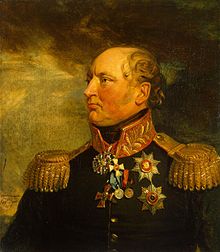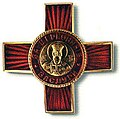Friedrich von Löwis of Menar

Friedrich von Lowis of Monar , even Fedor Fedorovich of Loewis of Monar , ( Russian Фёдор Фёдорович Левиз ; born August 26 . Jul / 6. September 1767 greg. In Haapsalu , † April 4 jul. / 16th April 1824 greg. In Sehlen) was a Russian lieutenant general and Livonian land marshal . He is considered the "savior of the city of Riga" in August 1812 and was one of the most prominent military figures in the fight against the French Emperor Napoleon .
origin
The ancestors of the noble family Löwis of Menar descend from a Scottish nobleman from County Peebles in southern Scotland who lived at Castle Manor. The oldest family record refers to the year 1434 and names the Vogt Patryk of the Lowys of Mener. In the 17th century one of the descendants (presumably William Lewis (Löwis) † 1675), who could have been endangered for religious reasons, had to leave his home in Scotland and move to Sweden . He was the first Löwis who served in foreign armies and served as a lieutenant colonel under King Gustav II Adolf of Sweden . As a result of his merits, he was enfeoffed with the Panten and Nurmis estates in Livonia (today Latvia and Estonia ).
Life
Friedrich was born as the son of the Russian major general Reinhold Friedrich von Löwis of Menar from Nurmsi in Livonia and his wife Dorothea Elisabeth Clapier de Colongue from the house of Samma . He married Johanna Wilhelmine Freiin von Posse from the Woidoma family in Livonia on September 24, 1797 . With her he had the children Gotthard August (1801), Johanna Wilhelmine (1807), Alexander (1809), Anna Juliane (1818) and Elisabeth (1820). His brother was the forester Andreas von Löwis of Menar (1777-1839).
Military career
In 1782 he joined the Russian army and served as a major in the Russian-Swedish war in Finland from 1788 to 1790 . As a lieutenant colonel he served in Poland in 1792 and received the Russian Order of St. George IV class in recognition of his achievements . This was followed by the promotion to colonel in 1799, the command of the Riga carbine regiment . With the promotion to major general he led the cuirassier regiment "Löwis" and then in 1800 he became chief of the former Ekatarinoslavsche cuirassier regiment. Due to illness, von Löwis of Menar had to suspend his military service between 1802 and 1805 in order to immediately become chief of the Yaroslav Musketeer Regiment . From 1806 to 1807 he served in the corps " von Essen " and was in this use with the Order of St. Vladimir III. Class and the Russian Order of St. Anne I. Class. In 1808 he took command of the 10th Infantry Division as Lieutenant General . In 1809, during the Austrian campaign against the Duchy of Warsaw , he was deployed in Galicia against the Austrians without a fight with the Austrians. In the Russo-Turkish War he was corps commander in Wallachia and Bulgaria from 1810 to 1811 , where he thwarted the encirclement of the Ottoman army . In 1811 he fell ill again and was temporarily decommissioned ( retired ), but reactivated in 1812. He then found a use in the "Corps of Essen" in Courland and led the battle near Keckau , he saved Riga from the siege and he was awarded the Order of St. George III. Class honored. He then led the siege of Danzig until the surrender in November 1813 and was decorated with the golden saber of honor with diamonds . His last service he provided as commander of the 25th Infantry Division and was out of the military service in 1813 adopted .
Lieutenant General Friedrich von Löwis of Menar was an honorable and well-known commander in the fight against Napoleon's supremacy over Europe . He managed to get Tsar Alexander I of Russia , King George III. of England , King Friedrich Wilhelm III. of Prussia and Emperor Franz I of Austria to lead to a European alliance . Together with Blücher , Wellington , Scharnhorst and Gneisenau , he fought against the French occupiers.
Savior of Riga
In August 1812 it became known that a Prussian auxiliary corps (at that time allies of Napoleon under the command of Colonel Heinrich Wilhelm von Horn ) had taken up position on the Mückenberg south of the island of Dahlenholm with over 100 cannons and around 3000 soldiers . With this, Riga was to be besieged and taken. As a tactical measure, the war governor of Riga, Lieutenant General von Essen, had the suburbs burned down on the night of July 11th to 12th, 1812 and ordered Lieutenant General von Löwis of Menar to fight the Prussians. Löwis faced the enemy with almost 7,000 soldiers and an unknown number of artillery along the left bank of the Daugava to Ķekava south of Dahlen. The 18-year-old student Friedrich von Berg, disguised as a farmer, explored the battlefield under particularly difficult conditions. At four in the morning Löwis launched the counterattack, the Prussians were attacked from both sides and withdrew to the south with heavy losses. This victory saved Riga from siege and possible continuous fire.
State politician
After his military service, von Löwis of Menar only bought the Weissensee and Kawwern estates in 1818 and Üllenorm in Livonia in 1820 . In 1823 he inherited Bergshof in Livonia, to which Lehnen, Welden, Arrendebes and Grobin Castle in Courland were attached. Already in 1803 he received the Courland indigenous . He was the Livonian Land Marshal from 1818 to 1822 . Due to political disagreements with the Governor General Marquis Philip Osipovich Paulucci , he resigned from his office. He accompanied Tsar Alexander I of Russia and King Friedrich Wilhelm III. of Prussia during their visits to the Baltic States.
See also
literature
- Henning von Löwis of Menar (Ed.): I would have liked to stay. The life of Friedrich von Löwis of Menar between 1767 and 1824 along with some family news and a question about Alexander Pushkin's connection to the house of Löwis of Menar . Konrad Reich, Rostock 2006, ISBN 3-86167-151-4 .
- Reinhold von Klot: Lieutenant General Friedrich von Löwis of Menar, savior of the city of Riga in August 1812 . In: Baltic letters , edited by Ingeborg von Kleist, year 2015, no. 3/4 (= no. 797/798). Publishing house Baltic letters - Wolf J. von Kleist, Großhansdorf 2015.
Web links
- Baltic Historical Commission (Ed.): Entry on Friedrich von Löwis of Menar. In: BBLD - Baltic Biographical Lexicon digital
- The ancestor would have liked to stay, his memories hold him fast . In: Daily Anzeiger - Holzminden (TAH) from May 26, 2012, accessed on May 4, 2015,
- Alexander Mikaberidze: Russian Generals of the Napoleonic Wars: Lieutenant General Friedrich von Lowis of Menar (English)
- Photo gallery on www.menar
References and comments
- ↑ a b Scots in Eastern and Western Prussia, Part II - Military, Ecclesiastical and other Matters (1) on electricscotland.com.
- ↑ The ancestor would have liked to stay, his memories hold him fast . In: Daily Anzeiger - Holzminden (TAH) of May 26, 2012, accessed on May 4, 2015.
- ^ Genealogical handbook of the Baltic knighthoods , part 1.1: Livonia, p. 107.
- ^ Andreas von Loewis of Menar, Neuschäffer, Hubertus, "Loewis of Menar, Andreas von" in: Neue Deutsche Biographie 15 (1987), p. 110 f. ( Online version ).
- ^ Genealogisches Handbuch des Adels , Volume 129, CA Starke Verlag Limburg an der Lahn 2002, pp. 219f.
- ↑ 1855–1861 Governor General of Finland, 1856 Count, 1863–1874 Governor in Tender Poland, 1866 Field Marshal General.
- ↑ Reinhold von Klot: Lieutenant General Friedrich von Löwis of Menar - Savior of the City of Riga in August 1812. In: Baltische Briefe, No. 3/4 (797/798), March / April 2015.
| personal data | |
|---|---|
| SURNAME | Löwis of Menar, Friedrich von |
| ALTERNATIVE NAMES | Loewis of Menar, Fedor Fedorovich of; Левиз, Фёдор Фёдорович (Russian) |
| BRIEF DESCRIPTION | Russian lieutenant general, state politician |
| DATE OF BIRTH | September 6, 1767 |
| PLACE OF BIRTH | Haapsalu |
| DATE OF DEATH | April 16, 1824 |
| Place of death | Sehlen |


